Mysql count
Download as ODP, PDF1 like1,057 views
MySQL COUNT() function returns a count of number of non-NULL values of a given expression. If it does not find any matching row, it returns 0.
1 of 8
Download to read offline

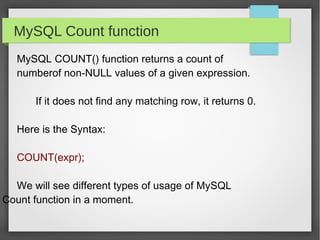
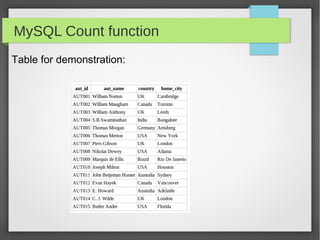
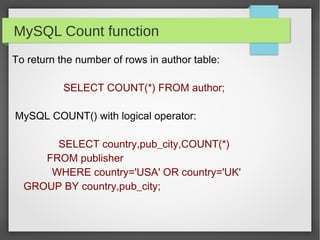
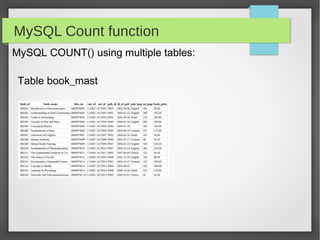
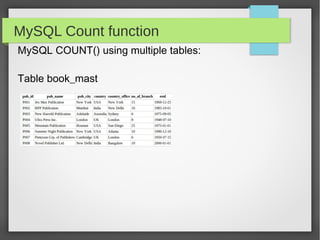
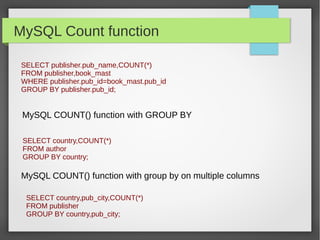
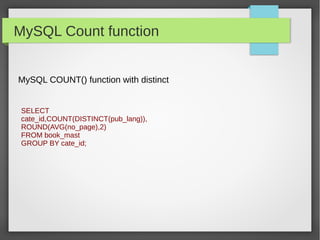
Recommended
Do something in 5 with gas 7-email log



Do something in 5 with gas 7-email logBruce McPherson
?
number 7 in do something useful with Google Apps script, covers how to search gmail for threads matching a topic and log recipients to a spreadsheet.Do something in 5 with gas 2-graduate to a database



Do something in 5 with gas 2-graduate to a databaseBruce McPherson
?
Here's how to migrate your backend Google Apps Script spreadsheet to a parse.com database in a few minutes.Selection Sort on Linked list



Selection Sort on Linked listHananBahy
?
The document discusses selection sort algorithms for both ordinary lists and linked lists in Python. It includes code snippets showing the selection sort process for sample data in an ordinary list and linked list. It also provides UML diagrams for a Node class and LinkedList class with relevant methods like selectionsort. Tests were run comparing the time to selection sort 10000 random items in a normal list versus linked list.Lab 1



Lab 1rimshailyas1
?
The document contains two questions asking to implement data structures in C++. Question 1 asks to implement methods for a singly linked list including returning size, printing, checking containment, adding, and removing values. Question 2 asks to implement methods for a queue using an array including initializing, checking for empty/full, accessing front/back, adding, and removing elements. Sample code is provided for both a linked list and queue implementation with the required methods.DuplicatesRDemo



DuplicatesRDemoAnthony Castellani
?
This document demonstrates how to reconcile two similar but not identical spreadsheets using R. It creates sample datasets from a source spreadsheet, called spreadsheet A and B. It then uses dplyr functions like union, intersect, and setdiff to combine the datasets, find common rows, and identify unique rows in each spreadsheet. This allows identifying differences between the spreadsheets and reconciling the data in a few lines of code.Do something in 5 with gas 4- Get your analytics profiles to a spreadsheet



Do something in 5 with gas 4- Get your analytics profiles to a spreadsheetBruce McPherson
?
Another in the 'do something useful with Google Apps Script' series. This time you'll see how to use the Analytics service and use exponential backoff to mitigate for quota rate limiting.Do something in 5 minutes with gas 1-use spreadsheet as database



Do something in 5 minutes with gas 1-use spreadsheet as databaseBruce McPherson
?
Here's one in a series of tutorials where you can do something useful from scratch in 5 minutes using Google Apps Script. This example shows how to use a Google Spreadsheet as a databaseIntroduction tomongodb



Introduction tomongodbLee Theobald
?
This document introduces MongoDB, an open-source document database. It describes MongoDB as schema-less, highly scalable, and capable of replication and auto-sharding. Key features include storing data as JSON documents, a familiar database and collection structure, easy insertion and querying of documents, and aggregation of data using map-reduce functions. The document encourages readers to try MongoDB themselves by downloading it or exploring online tutorials.Mi primer map reduce



Mi primer map reduceRuben Orta
?
Este a?o se cumple el 10? aniversario de la publicaci┏n de uno de los papers que m│s impacto han tenido en la evoluci┏n de Internet. Elaborado por dos ingenieros de Google, supuso el pistoletazo de salida para el surgimiento de las tecnolog┴as que se engloban dentro del concepto Big Data. En la charla introduciremos los conceptos b│sicos de este modelo de programaci┏n y realizaremos un ejemplo utilizando el lenguaje python.Do something in 5 with gas 3-simple invoicing app



Do something in 5 with gas 3-simple invoicing appBruce McPherson
?
quick 5 minute tutorial. join multiple databases and create personalized email invoices with google apps scriptMi primer map reduce



Mi primer map reducebetabeers
?
This document discusses MapReduce and provides an example implementation in Python using the MinceMeat library to solve the Netflix Prize problem. It first explains the MapReduce model developed by Google with key-value pairs and separate mapping and reducing functions. It then shows sample mapping and reducing functions to count word frequencies in web pages as an example. Finally, it shows code using MinceMeat to map and reduce movie rating data to find the number of movies each user rated.Do something useful in Apps Script 5. Get your analytics pageviews to a sprea...



Do something useful in Apps Script 5. Get your analytics pageviews to a sprea...Bruce McPherson
?
Here's how to build on previous tutorials to get your Google Analytics PageView data into a Spreadsheet.RxSubject And Operators



RxSubject And OperatorsSeven Peaks Speaks
?
In this iteration of iOS Meetup, The experts from Seven Peaks Software will walk you through on the Swift programming language, Giving you the latest tips and tricks for you to be success on the iOS development
Saravudh dived deep into RXSwift: Subjects & Operators. RxSwift is a famous library for composing asynchronous and event-based programs by using observable sequences. Subject and Operation are fundamentals of RxSwift. His topic will lead to a better understanding of the mechanism and behavior of subjects and the main combination operators in RxSwift. It is beneficial to begin by learning the fundamentals.Async task



Async taskLwp Xd
?
This document defines an AsyncTask class that executes work asynchronously on a background thread. The AsyncTask takes a double as a parameter, does not update progress, and returns a string. It overrides methods like doInBackground to run work on a background thread, onProgressUpdate to handle progress updates, and onPostExecute to run after work is completed.Unit 6: Functions and Subroutines - Part 2/2



Unit 6: Functions and Subroutines - Part 2/2Matthew Campbell, OCT
?
This document discusses Excel macros and functions/subroutines. It provides examples of using ByRef and ByVal parameters to determine if an argument is passed by reference or by value. When an argument is passed by reference, any changes made to it within the procedure will persist outside the procedure. When passed by value, changes are local to the procedure.Gratest



GratestAnkit Dubey
?
This program finds the largest of three input numbers. It takes three integer values as input from the user and compares them using if/else statements to determine which number is largest. It then prints out the largest number.Presentation topic is stick data structure



Presentation topic is stick data structureAizazAli21
?
This document discusses the stack data structure. It defines a stack as a linear data structure where elements are added and removed from only one end, called the top. Common stack operations like push, pop, and peek are described. Examples are given to illustrate how stacks can be used to perform calculations. The document also explains how stacks can be implemented using both arrays and linked lists. Key points are that arrays maintain a size and add/remove from the first element, while linked lists use a head node and insert/remove as the new head.CSC103 Web - JavaScript



CSC103 Web - JavaScriptRichard Homa
?
This document discusses variables and functions in JavaScript. Variables can represent different data types and be used to store and represent data. Functions contain statements and instructions to perform tasks and can be called using events like onclick to trigger the function. Examples are provided of using variables to store and display random numbers generated by JavaScript, which could aid in creating a rock-paper-scissors game by having the computer randomly select rock, paper, or scissors for each round.Functional programming 



Functional programming Nyarai Tinashe Gomiwa
?
This document provides a brief introduction to functional programming concepts including pure functions, higher order functions, avoiding side effects, and using declarative rather than imperative style. It emphasizes composing software with pure functions, treating functions as first-class objects, and using map and reduce functions over iteration to transform and combine collections of data in a non-mutating way.Synapse india dotnet development overloading operater part 4



Synapse india dotnet development overloading operater part 4Synapseindiappsdevelopment
?
Synapse india dotnet development overloading operater part 4
SynapseIndia PHP Development,
SynapseIndia Magento Development,
SynapseIndia Reviews,
SynapseIndia Complaints,
SynapseIndia Sharepoint Development,
SynapseIndia dotnet DevelopmentData Visualization With R: Learn To Modify Title, Axis Labels & Range



Data Visualization With R: Learn To Modify Title, Axis Labels & RangeRsquared Academy
?
This document contains slides from a data visualization course in R. It discusses how to modify the title, axis labels, and range of plots created in R. Specifically, it shows how to add these elements either by including arguments in the plot() function or by using the title() function. The title(), xlab, ylab, xlim, and ylim arguments can be used in plot() to customize the title, axis labels, and ranges. Alternatively, the title() function can be used after plotting but may overwrite default axis labels, so the ann argument should be set to FALSE in plot().Testowanie JavaScript



Testowanie JavaScriptTomasz Bak
?
This document discusses testing JavaScript with the Jasmine testing framework. It provides an overview of why to use JavaScript and Jasmine for testing, how Jasmine integrates well with Rails and supports CoffeeScript. It demonstrates sample tests written in JavaScript and CoffeeScript using Jasmine's matchers and other features. Finally, it provides a link to a GitHub repository with a demo of testing JavaScript with Jasmine.Weather scraper for your data warehouse



Weather scraper for your data warehouseFru
?
This is a fairly easy project, but worth while. I created this scraper using free API to get weather information for a data warehouse. With detailed weather information by date and zip codes at your disposal, you can tie this with location information in your database or data warehouse to do extensive querying/analytics. E.g.
? How does rain affect my sales by region
? How does humidity affect sales
? How does cloud cover affect sales
? How does weather affect tips
? How does weather affect Employee productivity
The sky (pun intended) is virtually the limit on this.
Good Luck. NCCU: Statistics in the Criminal Justice System, R basics and Simulation - Pr...



NCCU: Statistics in the Criminal Justice System, R basics and Simulation - Pr...The Statistical and Applied Mathematical Sciences Institute
?
R is a free software environment for statistical computing and graphics that provides a wide variety of statistical techniques and graphical methods. It includes base functions and packages, and is used through interfaces like RStudio. R represents data using objects like vectors, matrices, and data frames. Common operations include calculations, generating random variables, and visualizing data. R can be used to analyze a glass fragment dataset to visualize compositions and potentially classify an unknown fragment.PHP mysql Mysql joins



PHP mysql Mysql joinsMudasir Syed
?
The document discusses different types of joins in MySQL including inner joins, outer joins, cross joins, equi joins, natural joins, and self joins. Inner joins return rows that match between two tables, while outer joins return all rows from one or both tables even if they don't match. Cross joins perform a Cartesian product between tables, equi joins combine tables based on common columns, and natural joins compare columns with the same name. Self joins allow retrieving related records from a single table that references itself.MySQL JOIN & UNION



MySQL JOIN & UNIONJamshid Hashimi
?
This document provides an overview of MySQL JOIN and UNION operations. It discusses subqueries, table aliases, multi-table joins, UNION ALL, UNION rules, and GROUP BY. Subqueries allow querying data from multiple tables in a nested format. Table aliases are used to temporarily rename tables and columns for readability. JOIN operations combine data from two or more tables, including INNER JOIN, LEFT JOIN, and RIGHT JOIN. UNION combines the results of multiple SELECT statements, requiring the same number and order of columns. UNION rules specify that data types must be compatible. GROUP BY is used to retrieve aggregate information about grouped data.Types of Error in PHP



Types of Error in PHPVineet Kumar Saini
?
There are four main types of errors in PHP:
1. Parse (Syntax) Errors occur due to syntax mistakes and stop script execution. Common causes are unclosed quotes, missing parentheses, etc.
2. Fatal Errors are caused when PHP understands the code but can't perform the requested action, like calling an undefined function, and stop execution.
3. Warning Errors do not stop execution, examples include missing files or wrong number of function parameters.
4. Notice Errors are like Warning Errors in that execution continues, and occur when accessing undefined variables.Database normalization



Database normalizationJignesh Jain
?
This document discusses database normalization. It begins by defining normalization as the process of removing redundant data from tables to improve storage efficiency, data integrity, and scalability. It then discusses the various normal forms (1NF, 2NF, 3NF, BCNF, etc.) and what conditions a database needs to satisfy to be in each normal form. Examples are provided to demonstrate how to normalize tables that are not in a specific normal form into tables that satisfy that normal form. The document also provides a brief history of normalization and defines some key terms.Join-fu: The Art of SQL Tuning for MySQL



Join-fu: The Art of SQL Tuning for MySQLZendCon
?
Join-fu is the art of performance-tuning your application's SQL. Join Jay in a fun, irreverent look at the common ways application developers misuse and abuse their database.MySQL Query And Index Tuning



MySQL Query And Index TuningManikanda kumar
?
This document discusses various strategies for optimizing MySQL queries and indexes, including:
- Using the slow query log and EXPLAIN statement to analyze slow queries.
- Avoiding correlated subqueries and issues in older MySQL versions.
- Choosing indexes based on selectivity and covering common queries.
- Identifying and addressing full table scans and duplicate indexes.
- Understanding the different join types and selecting optimal indexes.More Related Content
What's hot (16)
Mi primer map reduce



Mi primer map reduceRuben Orta
?
Este a?o se cumple el 10? aniversario de la publicaci┏n de uno de los papers que m│s impacto han tenido en la evoluci┏n de Internet. Elaborado por dos ingenieros de Google, supuso el pistoletazo de salida para el surgimiento de las tecnolog┴as que se engloban dentro del concepto Big Data. En la charla introduciremos los conceptos b│sicos de este modelo de programaci┏n y realizaremos un ejemplo utilizando el lenguaje python.Do something in 5 with gas 3-simple invoicing app



Do something in 5 with gas 3-simple invoicing appBruce McPherson
?
quick 5 minute tutorial. join multiple databases and create personalized email invoices with google apps scriptMi primer map reduce



Mi primer map reducebetabeers
?
This document discusses MapReduce and provides an example implementation in Python using the MinceMeat library to solve the Netflix Prize problem. It first explains the MapReduce model developed by Google with key-value pairs and separate mapping and reducing functions. It then shows sample mapping and reducing functions to count word frequencies in web pages as an example. Finally, it shows code using MinceMeat to map and reduce movie rating data to find the number of movies each user rated.Do something useful in Apps Script 5. Get your analytics pageviews to a sprea...



Do something useful in Apps Script 5. Get your analytics pageviews to a sprea...Bruce McPherson
?
Here's how to build on previous tutorials to get your Google Analytics PageView data into a Spreadsheet.RxSubject And Operators



RxSubject And OperatorsSeven Peaks Speaks
?
In this iteration of iOS Meetup, The experts from Seven Peaks Software will walk you through on the Swift programming language, Giving you the latest tips and tricks for you to be success on the iOS development
Saravudh dived deep into RXSwift: Subjects & Operators. RxSwift is a famous library for composing asynchronous and event-based programs by using observable sequences. Subject and Operation are fundamentals of RxSwift. His topic will lead to a better understanding of the mechanism and behavior of subjects and the main combination operators in RxSwift. It is beneficial to begin by learning the fundamentals.Async task



Async taskLwp Xd
?
This document defines an AsyncTask class that executes work asynchronously on a background thread. The AsyncTask takes a double as a parameter, does not update progress, and returns a string. It overrides methods like doInBackground to run work on a background thread, onProgressUpdate to handle progress updates, and onPostExecute to run after work is completed.Unit 6: Functions and Subroutines - Part 2/2



Unit 6: Functions and Subroutines - Part 2/2Matthew Campbell, OCT
?
This document discusses Excel macros and functions/subroutines. It provides examples of using ByRef and ByVal parameters to determine if an argument is passed by reference or by value. When an argument is passed by reference, any changes made to it within the procedure will persist outside the procedure. When passed by value, changes are local to the procedure.Gratest



GratestAnkit Dubey
?
This program finds the largest of three input numbers. It takes three integer values as input from the user and compares them using if/else statements to determine which number is largest. It then prints out the largest number.Presentation topic is stick data structure



Presentation topic is stick data structureAizazAli21
?
This document discusses the stack data structure. It defines a stack as a linear data structure where elements are added and removed from only one end, called the top. Common stack operations like push, pop, and peek are described. Examples are given to illustrate how stacks can be used to perform calculations. The document also explains how stacks can be implemented using both arrays and linked lists. Key points are that arrays maintain a size and add/remove from the first element, while linked lists use a head node and insert/remove as the new head.CSC103 Web - JavaScript



CSC103 Web - JavaScriptRichard Homa
?
This document discusses variables and functions in JavaScript. Variables can represent different data types and be used to store and represent data. Functions contain statements and instructions to perform tasks and can be called using events like onclick to trigger the function. Examples are provided of using variables to store and display random numbers generated by JavaScript, which could aid in creating a rock-paper-scissors game by having the computer randomly select rock, paper, or scissors for each round.Functional programming 



Functional programming Nyarai Tinashe Gomiwa
?
This document provides a brief introduction to functional programming concepts including pure functions, higher order functions, avoiding side effects, and using declarative rather than imperative style. It emphasizes composing software with pure functions, treating functions as first-class objects, and using map and reduce functions over iteration to transform and combine collections of data in a non-mutating way.Synapse india dotnet development overloading operater part 4



Synapse india dotnet development overloading operater part 4Synapseindiappsdevelopment
?
Synapse india dotnet development overloading operater part 4
SynapseIndia PHP Development,
SynapseIndia Magento Development,
SynapseIndia Reviews,
SynapseIndia Complaints,
SynapseIndia Sharepoint Development,
SynapseIndia dotnet DevelopmentData Visualization With R: Learn To Modify Title, Axis Labels & Range



Data Visualization With R: Learn To Modify Title, Axis Labels & RangeRsquared Academy
?
This document contains slides from a data visualization course in R. It discusses how to modify the title, axis labels, and range of plots created in R. Specifically, it shows how to add these elements either by including arguments in the plot() function or by using the title() function. The title(), xlab, ylab, xlim, and ylim arguments can be used in plot() to customize the title, axis labels, and ranges. Alternatively, the title() function can be used after plotting but may overwrite default axis labels, so the ann argument should be set to FALSE in plot().Testowanie JavaScript



Testowanie JavaScriptTomasz Bak
?
This document discusses testing JavaScript with the Jasmine testing framework. It provides an overview of why to use JavaScript and Jasmine for testing, how Jasmine integrates well with Rails and supports CoffeeScript. It demonstrates sample tests written in JavaScript and CoffeeScript using Jasmine's matchers and other features. Finally, it provides a link to a GitHub repository with a demo of testing JavaScript with Jasmine.Weather scraper for your data warehouse



Weather scraper for your data warehouseFru
?
This is a fairly easy project, but worth while. I created this scraper using free API to get weather information for a data warehouse. With detailed weather information by date and zip codes at your disposal, you can tie this with location information in your database or data warehouse to do extensive querying/analytics. E.g.
? How does rain affect my sales by region
? How does humidity affect sales
? How does cloud cover affect sales
? How does weather affect tips
? How does weather affect Employee productivity
The sky (pun intended) is virtually the limit on this.
Good Luck. NCCU: Statistics in the Criminal Justice System, R basics and Simulation - Pr...



NCCU: Statistics in the Criminal Justice System, R basics and Simulation - Pr...The Statistical and Applied Mathematical Sciences Institute
?
R is a free software environment for statistical computing and graphics that provides a wide variety of statistical techniques and graphical methods. It includes base functions and packages, and is used through interfaces like RStudio. R represents data using objects like vectors, matrices, and data frames. Common operations include calculations, generating random variables, and visualizing data. R can be used to analyze a glass fragment dataset to visualize compositions and potentially classify an unknown fragment.NCCU: Statistics in the Criminal Justice System, R basics and Simulation - Pr...



NCCU: Statistics in the Criminal Justice System, R basics and Simulation - Pr...The Statistical and Applied Mathematical Sciences Institute
?
Viewers also liked (8)
PHP mysql Mysql joins



PHP mysql Mysql joinsMudasir Syed
?
The document discusses different types of joins in MySQL including inner joins, outer joins, cross joins, equi joins, natural joins, and self joins. Inner joins return rows that match between two tables, while outer joins return all rows from one or both tables even if they don't match. Cross joins perform a Cartesian product between tables, equi joins combine tables based on common columns, and natural joins compare columns with the same name. Self joins allow retrieving related records from a single table that references itself.MySQL JOIN & UNION



MySQL JOIN & UNIONJamshid Hashimi
?
This document provides an overview of MySQL JOIN and UNION operations. It discusses subqueries, table aliases, multi-table joins, UNION ALL, UNION rules, and GROUP BY. Subqueries allow querying data from multiple tables in a nested format. Table aliases are used to temporarily rename tables and columns for readability. JOIN operations combine data from two or more tables, including INNER JOIN, LEFT JOIN, and RIGHT JOIN. UNION combines the results of multiple SELECT statements, requiring the same number and order of columns. UNION rules specify that data types must be compatible. GROUP BY is used to retrieve aggregate information about grouped data.Types of Error in PHP



Types of Error in PHPVineet Kumar Saini
?
There are four main types of errors in PHP:
1. Parse (Syntax) Errors occur due to syntax mistakes and stop script execution. Common causes are unclosed quotes, missing parentheses, etc.
2. Fatal Errors are caused when PHP understands the code but can't perform the requested action, like calling an undefined function, and stop execution.
3. Warning Errors do not stop execution, examples include missing files or wrong number of function parameters.
4. Notice Errors are like Warning Errors in that execution continues, and occur when accessing undefined variables.Database normalization



Database normalizationJignesh Jain
?
This document discusses database normalization. It begins by defining normalization as the process of removing redundant data from tables to improve storage efficiency, data integrity, and scalability. It then discusses the various normal forms (1NF, 2NF, 3NF, BCNF, etc.) and what conditions a database needs to satisfy to be in each normal form. Examples are provided to demonstrate how to normalize tables that are not in a specific normal form into tables that satisfy that normal form. The document also provides a brief history of normalization and defines some key terms.Join-fu: The Art of SQL Tuning for MySQL



Join-fu: The Art of SQL Tuning for MySQLZendCon
?
Join-fu is the art of performance-tuning your application's SQL. Join Jay in a fun, irreverent look at the common ways application developers misuse and abuse their database.MySQL Query And Index Tuning



MySQL Query And Index TuningManikanda kumar
?
This document discusses various strategies for optimizing MySQL queries and indexes, including:
- Using the slow query log and EXPLAIN statement to analyze slow queries.
- Avoiding correlated subqueries and issues in older MySQL versions.
- Choosing indexes based on selectivity and covering common queries.
- Identifying and addressing full table scans and duplicate indexes.
- Understanding the different join types and selecting optimal indexes.殻會坡脅乎岑祇議珂霞皆河晦蜘汐



殻會坡脅乎岑祇議珂霞皆河晦蜘汐Jinrong Ye
?
This document discusses MySQL and InnoDB. It provides an overview of moving from MyISAM to InnoDB as the default storage engine, best practices for MySQL configuration, and new features in MySQL 5.7 like online DDL and generated columns. It also covers topics like database administration, high availability, and performance optimization.Entity relationship diagram (erd)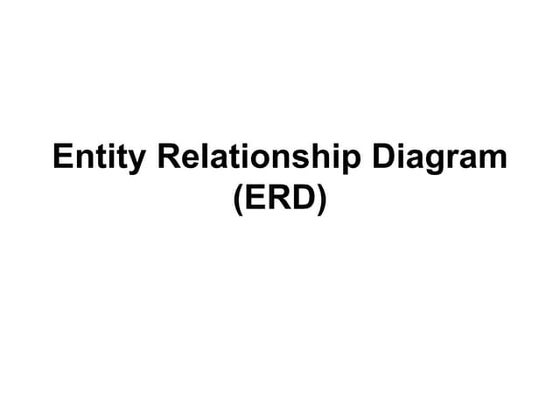



Entity relationship diagram (erd)tameemyousaf
?
The document provides information on entity relationship diagrams (ERDs), including the objectives, components, and steps to create an ERD. It defines key ERD concepts like entities, attributes, relationships, and cardinality. It describes the entity modeling process and discusses how to recognize entities, attributes, relationships, and cardinalities in a database. It outlines the general steps to create an ERD, including identifying entities, finding relationships between entities, drawing a rough ERD, defining primary keys, identifying attributes, mapping attributes to entities, and drawing a fully attributed ERD. Sample ERDs are provided to illustrate concepts like cardinality constraints.Similar to Mysql count (20)
ADV Powepoint 3 Lec.pptx



ADV Powepoint 3 Lec.pptxArjayBalberan1
?
The MySQL LIKE operator is used in SELECT statements to search for a pattern within a column and works with wildcard characters. It allows finding rows that match or contain a certain substring. The % wildcard represents zero, one, or multiple characters while _ represents a single character. Some examples of LIKE queries include finding rows where a column starts with, ends with, or contains a substring.Mysql



Mysqlmerlin deepika
?
MySQL is an open-source relational database management system based on SQL. It allows users to create, modify, and access database tables using standard SQL commands. Basic MySQL commands include CREATE TABLE, DROP TABLE, SELECT, INSERT, UPDATE, and DELETE.Mysql



MysqlYuvaraja Rajenderan
?
MySQL is an open-source relational database management system based on SQL. It allows users to create, modify, and access database tables using standard SQL commands. Basic MySQL commands include CREATE TABLE, DROP TABLE, SELECT, INSERT, UPDATE, and DELETE.Mysql



MysqlHAINIRMALRAJ
?
MySQL is an open-source relational database management system based on SQL. It allows users to create, modify, and access database tables using standard SQL commands. Basic MySQL commands include CREATE TABLE, DROP TABLE, SELECT, INSERT, UPDATE, and DELETE.Chapter 3 Quiz - RELATED TO INTRODUCTION TO Y SQL .pptx



Chapter 3 Quiz - RELATED TO INTRODUCTION TO Y SQL .pptxjosephinetagupa1
?
Chapter 3 Quiz - RELATED TO INTRODUCTION TO Y SQL - THE STARTARTING COMMANDS AND BASIC QUERY STATEMENTS OR SYNTAX.pptxMysql1



Mysql1rajikaa
?
The document provides information about MySQL including:
1. MySQL is an open source relational database management system based on SQL that is used to add, remove, and modify information in databases.
2. It describes basic MySQL commands like CREATE TABLE, DROP TABLE, SELECT, INSERT, UPDATE, and provides syntax examples.
3. It also covers advanced commands, functions in MySQL like aggregate functions, numeric functions and string functions as well as stored procedures.Python my SQL - create table



Python my SQL - create tableLearnbay Datascience
?
This presentation educate you about how to create table using Python MySQL with example syntax and Creating a table in MySQL using python.
For more topics stay tuned with Learnbay.ADV PPT 8 LAB.pptx



ADV PPT 8 LAB.pptxArjayBalberan1
?
The MySQL GROUP BY statement groups rows that have the same values into summary rows. It is often used with aggregate functions like COUNT(), MAX(), MIN(), SUM(), AVG() to group the result set by one or more columns. The GROUP BY statement syntax includes SELECT, FROM, WHERE, GROUP BY, and ORDER BY clauses. Examples show using GROUP BY to find the number of customers in each country and the number of orders sent by each shipper.Advanced MySQL Query Tuning



Advanced MySQL Query TuningAlexander Rubin
?
- The document discusses advanced techniques for optimizing MySQL queries, including topics like temporary tables, file sorting, order optimizations, and calculated fields.
- It provides examples of using indexes and index optimizations, explaining concepts like index types, index usage, key lengths, and covering indexes.
- One example shows how to optimize a query involving a calculated year() expression by rewriting the query to use a range on the date field instead.Structured query language(sql)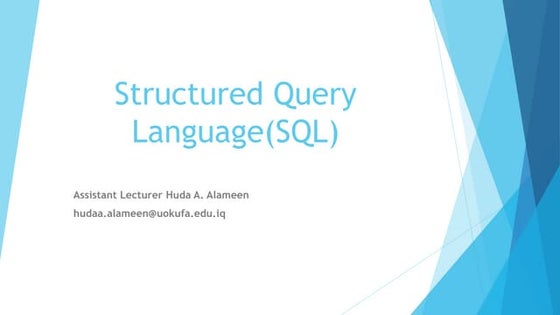



Structured query language(sql)Huda Alameen
?
The document discusses various SQL concepts including aggregate functions like MIN(), MAX(), COUNT(), AVG(), and SUM(); the GROUP BY clause; the HAVING clause; different types of joins like inner joins, outer joins, full outer joins; and examples of queries using these concepts.AGGREGATE FUNCTION.pptx



AGGREGATE FUNCTION.pptxAnusha sivakumar
?
This document discusses SQL aggregation functions such as COUNT, SUM, AVG, MAX, and MIN. It provides examples of using each function to aggregate data from a sample table containing employee names and page counts. The COUNT function returns the number of rows, SUM adds values, AVG calculates the average, MAX returns the largest value, and MIN returns the smallest value. Syntax examples are given for each function applied to the sample data.Mysqlppt



Mysqlpptpoornima sugumaran
?
MySQL is an open-source relational database management system that runs a server providing multi-user access to databases. It is commonly used with web applications and is popular for its use with PHP. Many large websites use MySQL to store user data. MySQL supports basic queries like SELECT, INSERT, UPDATE, and DELETE to retrieve, add, modify and remove data from databases. It also supports more advanced functions and queries.2 sql - single-row functions



2 sql - single-row functionsAnkit Dubey
?
This document summarizes key functions and concepts in Oracle SQL including:
- Single-row functions for text manipulation (UPPER, LOWER, SUBSTR), numbers (ROUND, TRUNC), and dates (MONTHS_BETWEEN, TO_DATE)
- The DUAL table which provides a single row for testing functions
- Creating views to restrict and present data and sequences to generate unique numbers
- Advanced queries using subqueries, joins, and multiple-row functionsMySQL-commands.pdf



MySQL-commands.pdfssuserc5aa74
?
The document discusses various SQL commands used for managing databases and querying data. It covers commands for creating and deleting databases and tables, inserting, updating, and deleting records, modifying table structures, grouping and filtering query results using aggregate functions and conditions, and ordering query results. Key SQL commands covered include CREATE, DROP, INSERT, UPDATE, DELETE, ALTER, SELECT, GROUP BY, HAVING, and ORDER BY.Sql functions



Sql functionsilias ahmed
?
SQL has built-in functions for performing calculations on data, including aggregate functions that return a single value calculated from column values (e.g. AVG, COUNT, MAX) and scalar functions that return a single value based on an input (e.g. UCASE, LEN, ROUND). The document provides examples of using functions like COUNT, SUM, AVG with the Orders table and explains that aggregate functions often require a GROUP BY statement to group the results properly.SQL CHEAT SHEET



SQL CHEAT SHEETGadiOrellana
?
This document provides a SQL cheat sheet covering various SQL concepts needed for job interviews. It covers JOINs (LEFT JOIN, INNER JOIN, multiple joins, self joins), time and date functions (DATE_PART(), EXTRACT(), INTERVAL), aggregate functions (COUNT(), SUM(), AVG(), MIN(), MAX()), window functions (PARTITION BY, ORDER BY, RANK(), DENSE_RANK(), ROW_NUMBER()), and set operators (UNION, UNION ALL). For each concept, it provides a brief explanation, graphical representation, and example interview question with its solution. The cheat sheet is intended to help review SQL concepts for technical interviews.Les10



Les10arnold 7490
?
The document discusses how to create and manage database tables. Key topics covered include using CREATE TABLE to define table structure, ALTER TABLE to modify tables, DROP TABLE to remove tables, and TRUNCATE TABLE to delete all rows. Datatypes, naming conventions, adding comments, and joining tables with subqueries are also summarized.Mysqlppt



Mysqlpptpoornima sugumaran
?
MySQL is an open-source relational database management system that runs on a server and allows for multi-user access to databases. It is commonly used with web applications and by popular websites. MySQL uses commands like SELECT, INSERT, UPDATE, and DELETE to retrieve, add, modify and remove data from databases. It also supports stored procedures and functions to organize more complex queries and calculations.More from Ritwik Das (6)
SQL JOIN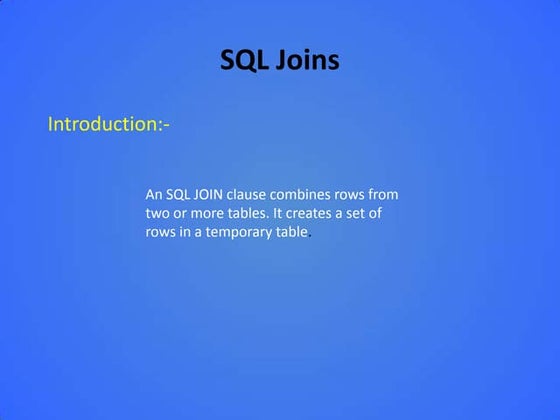



SQL JOINRitwik Das
?
The document discusses different types of SQL joins, including inner joins, outer joins, equi joins, non-equi joins, natural joins, cross joins, left joins, right joins, full outer joins, and self joins. It provides the syntax and examples for each type of join. It also discusses joining tables through referential integrity, where a foreign key references a primary key in another table to link the tables together.C if else



C if elseRitwik Das
?
The document discusses the if-else conditional statement in C programming. It provides the syntax and examples of using if-else statements to execute code conditionally based on whether an expression is true or false. This includes if-then statements with and without else blocks, multiway if-else statements, nested if statements, and examples checking the equality of variables and ranges of values.SQL UNION



SQL UNIONRitwik Das
?
The SQL UNION operator combines the results of two or more queries into a single result set. By default, UNION eliminates duplicate rows but UNION ALL includes duplicate rows. For UNION, the number and order of columns must match between queries and column data types must be compatible. Usually the column names from the first query are used. Examples demonstrate UNION, UNION ALL, and combining queries on the same table or with joins between tables.Concat presentation



Concat presentationRitwik Das
?
The MySQL CONCAT() function concatenates two or more strings by adding them together and returning the concatenated string. It will return a non-binary string if all arguments are non-binary, and a binary string if any argument is binary. Numeric arguments are also converted to their binary string equivalent. The CONCAT() function takes two or more string arguments and returns their concatenated value.Learning java



Learning javaRitwik Das
?
This document outlines the key topics one needs to learn to become proficient in Java programming. It discusses setting up the development environment, object-oriented programming concepts like inheritance and polymorphism, operators, flow control, exceptions handling, strings, file I/O, collections, threads, and miscellaneous utilities like dates and numbers. Mastering these fundamental Java concepts is essential for anyone looking to learn Java.Php variables



Php variablesRitwik Das
?
This presentation shows fundamentals of PHP
Variables - declaring variables, Variable scope
Static Variable and Reserved words. Mysql count
- 1. MySql COUNT() function Ref: w3resource MySQL Tutorial
- 2. MySQL Count function MySQL COUNT() function returns a count of numberof non-NULL values of a given expression. If it does not find any matching row, it returns 0. Here is the Syntax: COUNT(expr); We will see different types of usage of MySQL Count function in a moment.
- 3. MySQL Count function Table for demonstration:
- 4. MySQL Count function To return the number of rows in author table: SELECT COUNT(*) FROM author; MySQL COUNT() with logical operator: SELECT country,pub_city,COUNT(*) FROM publisher WHERE country='USA' OR country='UK' GROUP BY country,pub_city;
- 5. MySQL Count function MySQL COUNT() using multiple tables: Table book_mast
- 6. MySQL Count function MySQL COUNT() using multiple tables: Table book_mast
- 7. MySQL Count function SELECT publisher.pub_name,COUNT(*) FROM publisher,book_mast WHERE publisher.pub_id=book_mast.pub_id GROUP BY publisher.pub_id; MySQL COUNT() function with GROUP BY SELECT country,COUNT(*) FROM author GROUP BY country; MySQL COUNT() function with group by on multiple columns SELECT country,pub_city,COUNT(*) FROM publisher GROUP BY country,pub_city;
- 8. MySQL Count function MySQL COUNT() function with distinct SELECT cate_id,COUNT(DISTINCT(pub_lang)), ROUND(AVG(no_page),2) FROM book_mast GROUP BY cate_id;


